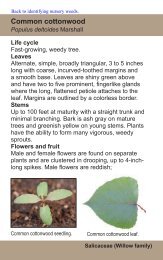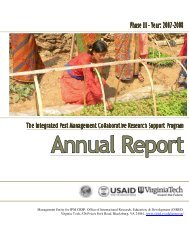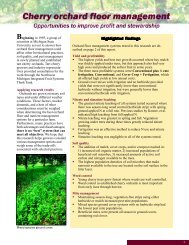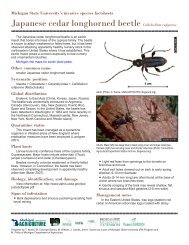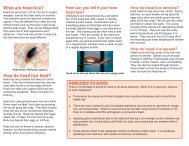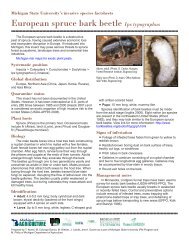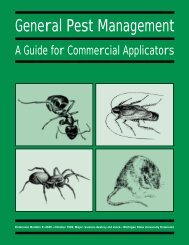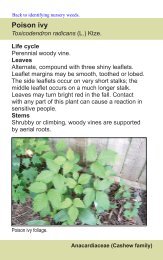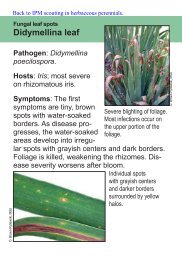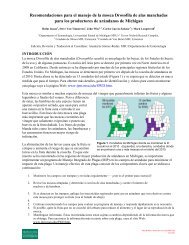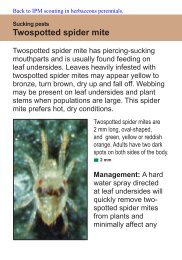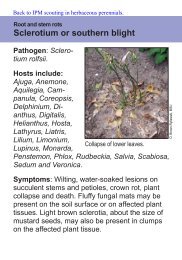Whole Manual - Michigan State University: Integrated Pest ...
Whole Manual - Michigan State University: Integrated Pest ...
Whole Manual - Michigan State University: Integrated Pest ...
You also want an ePaper? Increase the reach of your titles
YUMPU automatically turns print PDFs into web optimized ePapers that Google loves.
STOMACH POISON—A pesticide that must be eaten by<br />
a pest to be effective; it will not kill on contact.<br />
STOLONS—An aboveground creeping stem that can<br />
root and develop new shoots.<br />
STYLET—A long, slender, hollow feeding structure of<br />
nematodes and some insects.<br />
SUPPLEMENTAL LABELING—<strong>Pest</strong>icide label information<br />
that appears on a separate piece of paper and contains<br />
information regarding the site, pest, rate, etc.<br />
Supplemental labeling may be supplied at the time of<br />
purchase or requested from the dealer.<br />
SURFACE WATER—Water on the earth’s surface: rivers,<br />
lakes, ponds, streams, etc. (See also groundwater.)<br />
SUSPENSION—<strong>Pest</strong>icide mixtures consisting of fine<br />
particles dispersed or floating in a liquid, usually water<br />
or oil. Example: wettable powders in water.<br />
TARGET—The plants, animals, structures, areas, or pests<br />
at which the pesticide or other control method is directed.<br />
TAXONOMY—The classification of living organisms<br />
into groups: kingdom, phylum, class, order, family,<br />
genus, and species.<br />
TECHNICAL MATERIAL—The pesticide active ingredient<br />
in pure form as it is manufactured by a chemical<br />
company. It is combined with inert ingredients or additives<br />
in formulations such as wettable powders, dusts,<br />
emulsifiable concentrates, or granules.<br />
THORAX—The middle part of an insect’s body, between<br />
the head and the abdomen. It is divided into three segments—prothorax,<br />
mesothorax, and metathorax. A pair<br />
of legs is attached to each thoracic region.<br />
THRESHOLD—A level of pest density at which the pest<br />
or its damage becomes unacceptable and control measures<br />
are required.<br />
TOXIC—Poisonous to living organisms.<br />
TOXICANT—A poisonous substance such as the active<br />
ingredient in a pesticide formulation.<br />
TOXICITY—The ability of a pesticide to cause harmful,<br />
acute, delayed, or allergic effects; the degree or extent to<br />
which a chemical or substance is poisonous.<br />
TOXIN—A naturally occurring poison produced by<br />
plants, animals, or microorganisms. Examples: the poison<br />
produced by the black widow spider, the venom produced<br />
by poisonous snakes, and the botulism toxin produced<br />
by bacteria.<br />
UNCLASSIFIED PESTICIDE—See general-use pesticide.<br />
USE—The performance of pesticide-related activities<br />
requiring certification include: application, mixing, loading,<br />
transport, storage, or handling after the manufacturing<br />
seal is broken; care and maintenance of application<br />
and handling equipment; and disposal of pesticides and<br />
their containers in accordance with label requirements.<br />
Uses not needing certification: long-distance transport,<br />
long-term storage, and ultimate disposal.<br />
VAPOR PRESSURE—The property that causes a chemical<br />
to evaporate. The higher the vapor pressure, the more<br />
volatile the chemical or the easier it will evaporate.<br />
VECTOR—A carrier, an animal (e.g., insect, nematode,<br />
mite) that can carry and transmit a pathogen from one<br />
host to another.<br />
VERTEBRATE—Animal characterized by a segmented<br />
backbone or spinal column.<br />
VIRUS—Ultramicroscopic parasites composed of proteins.<br />
Viruses can multiply only in living tissues and<br />
cause many animal and plant diseases.<br />
VOLATILITY—The degree to which a substance<br />
changes from a liquid or solid state to a gas at ordinary<br />
temperatures when exposed to air.<br />
VOMITOXIN—A toxin produced by the fungus,<br />
Fusarium graminearm, wheat scab, that contaminates<br />
wheat; toxic to mammals.<br />
WATER TABLE—The upper level of the water-saturated<br />
zone in the ground.<br />
WETTABLE POWDER—A dry pesticide formulation in<br />
powder form that forms a suspension when added to<br />
water.<br />
For the further definition of terms consult:<br />
<strong>Pest</strong>icide Applicator Core Training <strong>Manual</strong>, E-2195,<br />
<strong>Michigan</strong> <strong>State</strong> <strong>University</strong> Extension.<br />
The Federal Insecticide, Fungicide, and Rodenticide Act<br />
as amended. Public Law 92-516 October 21, 1972 as<br />
amended by Public Law 94-140 November 28, 1975, and<br />
Public Law 95-396 September 30, 1978.<br />
Federal Register, November 7, 1990, Part II<br />
Environmental Protection Agency 40, CFR Part 171<br />
Certification of <strong>Pest</strong>icide Applicator; Proposed Rule.<br />
Region V Office of the EPA, Chicago, Ill.<br />
<strong>Michigan</strong> Department of Agriculture <strong>State</strong> Plan for<br />
Commercial and Private Applicators.<br />
Federal Agency Secretary’s Office (for federal employees<br />
using restricted pesticides in performance of official<br />
duties).<br />
Local, state, and national pest control associations.<br />
Appendix C<br />
98<br />
Vegetable Crop <strong>Pest</strong> Management



